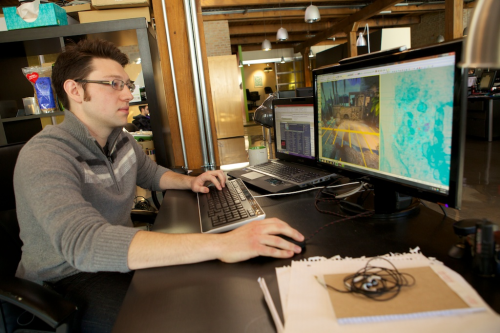Apr 23, 2013
DePaul powers up Chicago’s resurgent video game industry
DePaul powers up Chicago’s resurgent video game industry
CHICAGO — Big changes in the video gaming landscape have
given Chicago a new foothold in the industry.
In the first decade of the 21st century, Chicago was a major
player in game development. The city was flush with talent, and major studios
like Electronic Arts Chicago (“Madden NFL,” “The Sims”) and Midway Games
(“Mortal Kombat”) were churning out content for the then-new Xbox 360 and
Nintendo Wii. However, the recession late in the decade saw the end of many
local companies as major studios clustered in California, home to 42 percent of
video game industry employees.
Now, as players’ tastes migrate from big console games to
smaller mobile titles, a host of independent, upstart studios have surfaced in
the Windy City, staffed by a mix of newcomers and industry vets from the old
studios.
“Chicago’s video game history goes way back to the early
days of the gaming industry,” says Jose Zagal, assistant professor of game
development and interactive media at DePaul University’s College of Computing and
Digital Media. “Pinball is an important part of the history of Chicago, and
a lot of the early pinball companies moved into video games, Midway being the
most famous. So there is a tradition that has been in this town for a long time
now.”
Nick Guida, game developer at Chicago-based Phosphor Games, adds,
“If you go all the way back to Midway Games and all the great gaming history
that Chicago has, that’s really never gone away. Even though Midway has exploded
and been reincarnated as several dozen different studios, the same talent pool
exists here in Chicago, and it’s only growing – especially because schools like
DePaul are rooted in Chicago and bring in new talent every day.”
Indie studio
explosion
“The greater diversity in games and the platforms on which
they are available have allowed new companies to set up shop in new spaces,”
Zagal notes. “The way that the industry is structured is also changing and
opening up in many ways.”
Now that game distribution can be done digitally, many new
avenues have opened for indie studios to get their foot in the door by
marketing products directly to consumers.
“The industry is in an interesting place right now,” says
Travis Hernandez, game designer at Phosphor, which develops games for
cutting-edge platforms like the Xbox Kinect and the new WiiU, as well as the
recently released mobile adventure “Horn.” “Studios that don’t have a huge
financial backing or a lot of name recognition can put out games that they
think are interesting, and the world at large can decide what the next big
trend will be.”
Chicago’s role in new
industry
“We find 95 percent of our staff from within or around the
Chicagoland area,” says Phosphor Games Chief Executive Justin Corcoran. “With two
‘Game of the Year’ nominations under our belt, I feel that we are proof that
world-class gaming takes place in Chicago.”
Another successful Chicago-based studio, Barbaroga, has produced
award-winning games including “Spore Origins” and “Muppets Dance Party.” Despite the huge shift toward mobile games, Nick
Baker, a quality assurance tester at Barbaroga and a DePaul alumnus, sees them
existing alongside traditional console games and creating more opportunities
for the entire industry.
“With the mobile
platform expanding, there are many new studios that are forming, but the
console market is still very strong,” Baker says. “Many people predict that the
console market will eventually fade out, but I think consoles are going to stay
the same, and the mobile market will expand. Mobile games really appeal to
those who didn’t normally play games and are now being included.”
Adds Hernandez: “We’re seeing a lot of stuff on the mobile
market, with free games coming into their own and sort of dominating the
marketplace. It’s really changing the structure of how you make games and what
it means to be a studio. We’re in a state of flux right now as an industry, and
you can make and release quality games much more cheaply than you could before.
It’s a different way to invest your money, and it makes it really cool to be a
developer right now.”
DePaul’s
contributions to Chicago’s success
Much of the talent powering Chicago’s gaming scene comes
from DePaul’s College of
Computing and Digital Media. Since 2004, the school’s game development program
has been teaching students how to succeed in the industry, and many of them
have found homes in up-and-coming game design companies.
Corcoran has hired several Phosphor Games staff members from
DePaul. “It’s very important to find a school like DePaul that has very current
tools and teachers who know the industry,” he says.
“To be honest, I probably wouldn't have this job if I hadn't gone to DePaul,” Hernandez says. “It sure helped that I played video games since
I was a kid. But on top of that, DePaul showed me what programs that I would be
using, how to program and how to do the little things that I need to prototype
or build games on a day-to-day basis, not to mention that the job that I got
here was because of the professors that I knew at DePaul. It was great that we
could work with people who were in the industry and tie our education to the
careers we wanted to be getting into.”
“DePaul has lots of people who have worked in the industry,”
adds Joey Manso, software engineer at Phosphor. “You get the technical skills, but you can
learn those at a lot of different places. The difference at DePaul is having
those people who have worked at Midway or worked at EA, and you can ask them
specific questions, because any work environment is different than school
environments.”

Nick Guida, game developer at Chicago-based Phosphor Games. (Photos by Jeff Carrion/DePaul University)

Travis Hernandez, game designer at Phosphor, which develops games for cutting-edge platforms like the Xbox Kinect and the new WiiU, as well as the recently released mobile adventure “Horn.” (Photo by Jeff Carrion/DePaul University)
